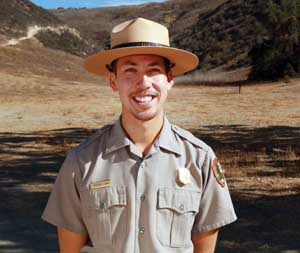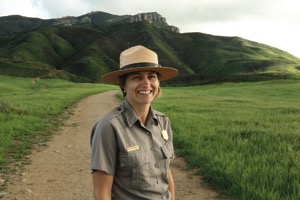Ahead of its centennial in 2016 the National Park Service is finding new ways to connect with the LGBT community.
Set up in 1916, the National Park Service is a bureau of the U.S. Department of the Interior and is led by a director nominated by the president and confirmed by the U.S. Senate. The current National Park Service director is Jonathan B. Jarvis. Confirmed as the 18th director in 2009, Jarvis oversees an agency whose mission is to preserve America’s most treasured landscapes and cultural icons.
The National Park Service is a huge enterprise consisting of 407 sites covering 84 million acres of land and attracting more than 275 million visitors a year.
San Diego County is home to three national parks: the Cabrillo National Monument with its historic lighthouse and expansive views, the tidepool at the same Cabrillo site and Torrey Pines State Beach.
The National Park Service employs more than 27,000 people; men and women who share a common trait – a passion for caring for the nation’s special places and sharing their stories.
Fully committed to equal opportunity the National Park Service prides itself on “… utilizing the potential that embracing diversity brings and is determined to become a model of inclusion and diversity.”
San Diego LGBT Weekly reached out to the National Park Service to learn of the Service’s involvement with the LGBT community and to talk to some of the Service’s LGBT rangers. We were fortunate to able to connect with Park Rangers Kate Kuykendall and Michael Liang who are both members of the LGBT community.
Kate Kuykendall is the public information officer for Santa Monica Mountains National Recreation Area and currently lives in the Southern California area with her wife and three kids.

Michael Liang is an advocate for increasing digital and visual literacy in the National Park Service. He has worked as an interpretive park ranger and visual information specialist, developing publications, multimedia projects and web and social media campaigns.
Both rangers have ‘found their park’ by connecting the LGBT community with the National Park Service and want to inspire others to do so as well.
“I love changing people’s perception about L.A. and also about national parks,” said Kuykendall. “When people think of L.A., they often think of traffic and smog. They’re shocked to learn that there’s a national park right in L.A.’s backyard and that the Santa Monica Mountains offer such an escape so close to the city. So I love challenging the stereotypes about L.A., particularly because I’m a native San Diegan and I grew up with all those stereotypes myself!”

California has 26 national parks and 279 state parks. Explaining the difference between these two designations Liang said it was all about who funds and manages these parks. The national parks are funded by Congress whereas the state parks are managed by the California Department of Parks and Recreation. “Bottom line,” said Liang “is that while the management and regulations may differ slightly between the two organizations, both represent a commitment to the public to protect and provide access to special and historically significant places.”
The National Park Service is proud of the fact that it celebrates diversity through the sites that it protects, public programming and internal employee initiatives. Explained Liang, “As a publicly funded federal agency, it is so important to have a system of national parks that represent the diversity of America. The story of our country is continually evolving, and additions like César E. Chávez National Monument and Manzanar National Historic Site help us share a more complete telling of the nation’s history.”
In 2014, the National Park Service announced a new theme study to identify sites of national significance related to LGBT history. Finding places that qualify for the National Register of Historic Places or as National Historic Landmarks is the first step toward having national parks that tell the LGBT community’s most important stories.
Kuykendall believes that the places and stories we honor should reflect the full diversity of our history. “I’m really excited about the LGBT Heritage Initiative,” said Kuykendall. “This initiative will chronicle the LGBT struggle for civil rights. New York’s Stonewall Inn, regarded by many as the birthplace of the modern LGBT civil rights movement, is already a national historic landmark, but there are many other significant places that need to be identified and commemorated as part of our nation’s history.”
Liang added that many parks have started creating public programs related to LGBT history, like the “Annual Reminder Days” at Independence National Historical Park or oral histories at Rosie the Riveter/World War II Home Front National Historical Park. “You might also see park rangers marching in Pride parades across the country,” said Liang, “like Bozeman, Montana, for Yellowstone employees.”
2016 is a year of special significance to the National Park Service as it celebrates its centennial. In March the National Park Service launched Find Your Park, a public awareness and education campaign celebrating the milestone centennial anniversary and setting the stage for the next 100 years. First Lady Michelle Obama and Mrs. Laura Bush will serve as honorary co-chairs to promote the celebration of the 2016 centennial and to encourage people to connect with their favorite parks and public lands.
Both Kuykendall and Liang are excited at the prospect of marking this important milestone. “We definitely want to commemorate 100 years of what many consider ‘America’s best idea,’” said Kuykendall. “But we also want to look forward to the next 100 years. For that reason, the focus of centennial activities will be connecting with our next generation of park visitors and supporters. In addition to park-specific events, our friends at the National Park Foundation are launching a public awareness campaign to re-introduce national parks to the American public.”
Find Your Park invites the public to see that a national park is more than just a place – it can be a feeling, a state of mind, or a sense of American pride. Beyond vast landscapes, the campaign highlights historical, urban and cultural parks, as well as National Park Service programs that protect, preserve and share nature, culture and history in communities nationwide. Further, Find Your Park encourages people to find their own personal connections within the network of national parks and public lands.
“For me, the heart of the campaign doesn’t come from a federal agency, but from our visitors,” said Liang. “You’ll be invited to share your stories on FindYourPark.com, which is like a giant national and multimedia guestbook. I love any opportunity to hear the public share their favorite experiences and tell us what is most significant to them about their national parks.”
The National Park system is indeed a national treasure and now more than ever it is a chance for Southern California residents to discover “their park” and enjoy the many benefits the park system has to offer. “As a native Southern Californian, I have to admit that I had no idea about national parks growing up, which is a shame because our area is blessed with so many wonderful places,” said Kuykendall. “San Diego of course has Cabrillo National Monument. For folks looking for a fun road trip, Joshua Tree National Park is a truly amazing place to visit. My family and I camped there last year for Easter and had a fun Easter egg hunt among the boulders and Joshua trees. And of course I’m pretty partial to my park, Santa Monica Mountains National Recreation Area, which has 500 miles of trails and some fascinating history for movie buffs.”
As an organization that embraces diversity and equal opportunity, the National Park Service welcomes members of the LGBT community. “This is a fantastic organization for LGBT employees and in my short career, I’ve never had any problems being an out and openly gay employee (and it helps that we now have federal benefits for same-sex couples, too),” said Liang. “At my previous National Park job in Philadelphia, I could actually stand at my desk and wave to five other gay or lesbian employees. So I think that people are pleasantly surprised to see how well-represented the LGBT community is within the agency, at many different types of parks and within various levels of management.”
Kuykendall agrees that the National Park Service is a great place to work. “Especially for anyone looking for a little adventure and a chance to learn more about our country,” Kuykendall adds. “My wife is also a park ranger and we’re part of the National Park Service family just like everyone else!”
• For more information on Find Your Park visit findyourpark.com
• For information on LGBT contributions to the workforce of the National Park Service visit www.nps.gov/diversity/lgbt.html












